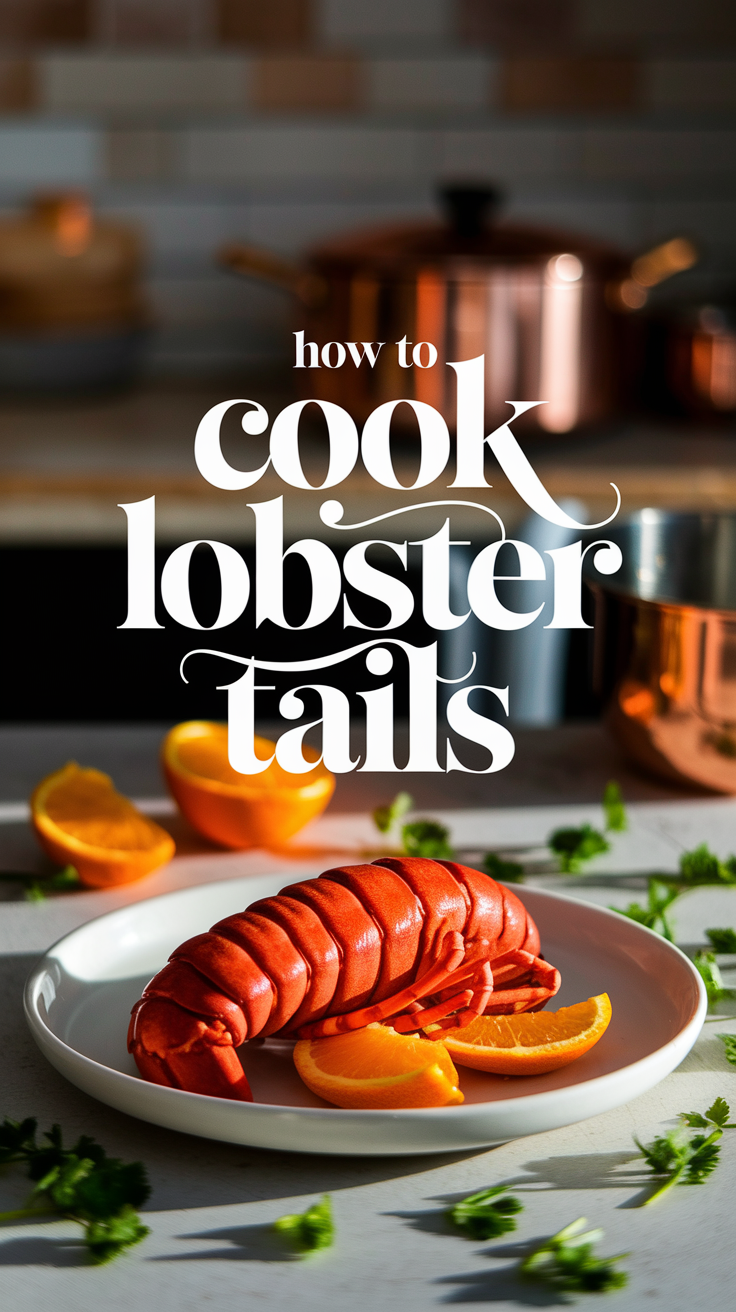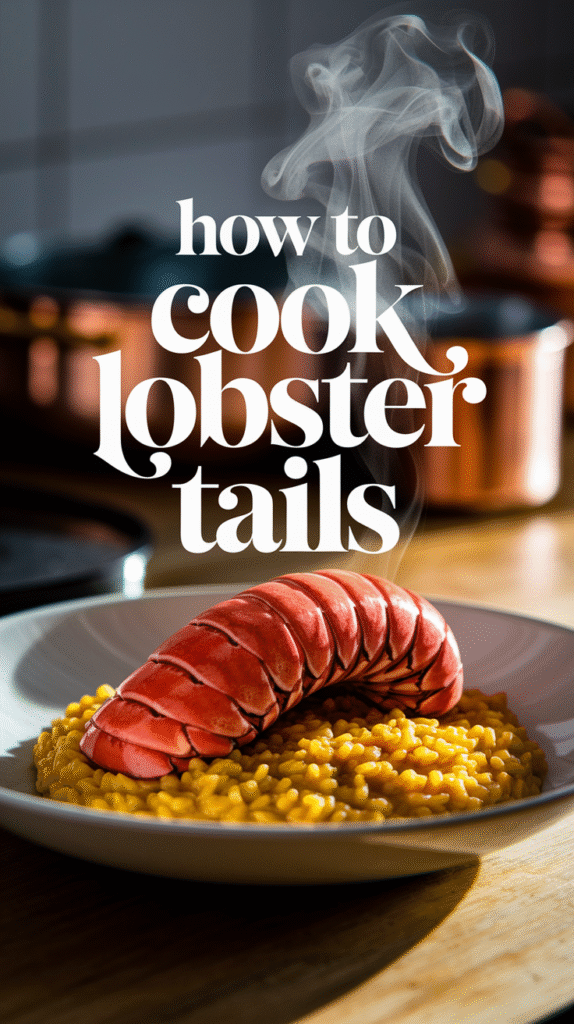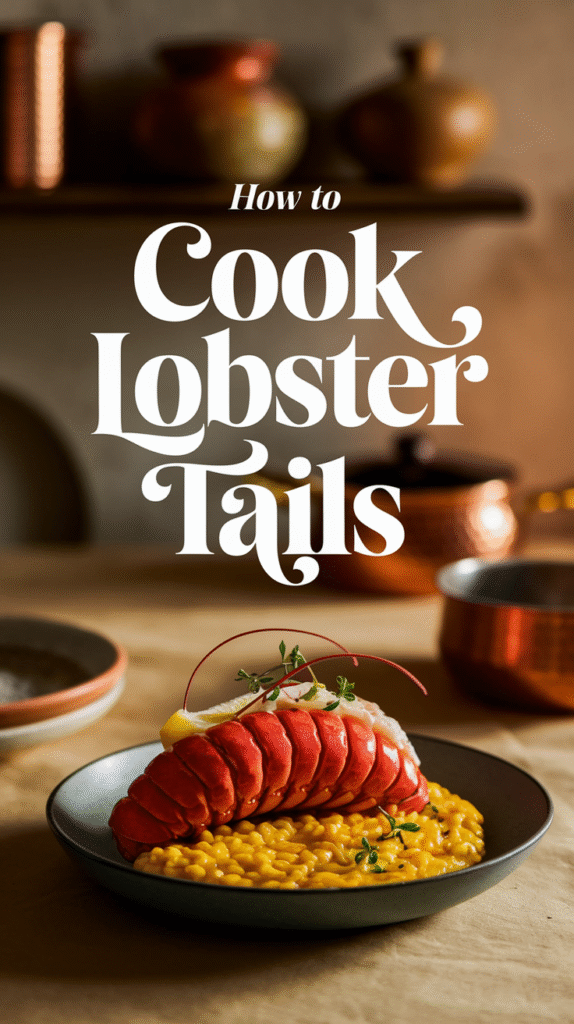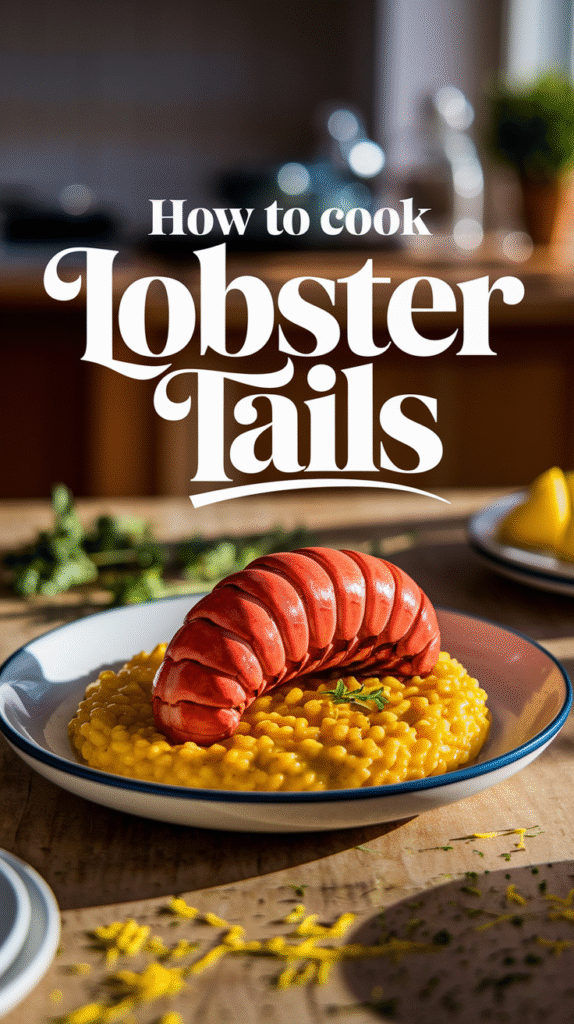Lobster tails are a delicacy that can elevate any dining experience, whether you’re preparing a gourmet meal at home or planning a special dinner for guests. Cooking lobster tails might seem intimidating at first, but with the right approach, you can create a delicious and impressive dish. Here’s a detailed guide on how to cook lobster tails, ensuring you achieve that tender and flavorful meat everyone loves.
Choosing the Right Lobster Tails
Before you dive into the cooking process, you need to select the lobster tails:
- Size: Opt for tails weighing between 4 to 6 ounces if you’re looking for a good serving size.
- Freshness: Choose tails that feel firm and have a clean ocean smell. Avoid any that have a strong, fishy odor.
- Color: Look for tails with a vibrant shell color, indicating they are fresh.
Cooking Methods
You can prepare lobster tails using various methods, including boiling, baking, grilling, and steaming. Each method offers a unique taste and texture. Here’s how to do it:
Boiling Lobster Tails
- Fill a large pot with water and add salt (about 1 tablespoon per quart). Bring the water to a rolling boil.
- Carefully drop the lobster tails into the boiling water. Make sure they are submerged.
- Cook for around 1-2 minutes per ounce. For example, if you have a 6-ounce tail, boil it for about 6-12 minutes.
- When done, the shells will turn bright red, and the meat will be opaque. Remove them and let cool.
Baking Lobster Tails
- Preheat your oven to 350°F (175°C).
- Using kitchen scissors, cut through the top of the shell, stopping at the fin.
- Gently pull the meat out and place it on top of the shell.
- Brush melted butter over the meat and sprinkle with salt and pepper.
- Bake for about 15-20 minutes or until the meat is opaque and firm.
Grilling Lobster Tails
- Preheat your grill to medium heat.
- Cut the lobster tails in half lengthwise.
- Brush the meat with olive oil and seasoning.
- Place them skin-side down on the grill. Grill for 5-8 minutes until the meat is opaque.
Steaming Lobster Tails
- Fill a pot with about 2 inches of water and add salt. Bring to a boil.
- Place a steaming rack in the pot and add the lobster tails, shell-side down.
- Cover and steam for 7-10 minutes or until the meat is cooked through.
Tips for the Perfect Lobster Tails
- Always thaw frozen lobster tails in the refrigerator overnight for best results.
- Don’t overcook the lobster; it should be firm yet tender.
- Experiment with seasonings. Garlic butter, lemon juice, and herbs pair wonderfully.
Serving Suggestions
Once cooked, serve your lobster tails with melted butter, garnished with lemon wedges and fresh herbs. They can be paired with side dishes like:
- Garlic mashed potatoes
- Steamed asparagus
- Rice pilaf
For more in-depth tips and techniques on preparing shellfish, you may find the articles on SeafoodSource helpful.
Cooking lobster tails at home can be an enjoyable venture that impresses your family and friends alike. By following these simple steps, you can create a mouthwatering dish that captures the rich, buttery flavor of lobster. Enjoy your culinary experience! Don’t forget to explore additional resources on buying and cooking seafood on Lobster from Maine.
Choosing the Best Lobster Tails for Cooking
When it comes to enjoying a delicious seafood feast, cooking lobster tails can be a delightful experience. However, selecting the right lobster tails is crucial to ensure you end up with a tasty meal. Here’s what you need to consider when choosing the best lobster tails for cooking.
Fresh vs. Frozen Lobster Tails
The first decision you need to make is whether to go for fresh or frozen lobster tails:
- Fresh Lobster Tails: If you can find them, fresh lobster tails will offer a sweeter, richer flavor. Look for tails that are firm to the touch, with a clean ocean smell.
- Frozen Lobster Tails: Often more accessible, frozen tails can be just as good as fresh if properly handled. Make sure they have been flash-frozen right after being caught. Check that the packages are tightly sealed and free from frost or ice crystals, as this indicates quality.
Size Matters
The size of the lobster tails plays a significant role in your cooking experience. Lobster tails are typically sold by weight, and here’s a simple guide to help you choose:
| Size Category | Weight (per tail) | Servings per Tail |
|---|---|---|
| Small | 3-4 oz | 1 |
| Medium | 5-7 oz | 1-2 |
| Large | 8-10 oz | 2 |
| Extra Large | 10-12 oz | 2-3 |
For most recipes, medium to large sizes are ideal. Just keep in mind that the larger the tail, the more cooking time it will require.
Color and Appearance
When evaluating lobster tails, examine their color and appearance:
- Look for lobster tails that are a vibrant reddish-brown or coral color, indicating freshness.
- Avoid any tails that appear discolored or dull, as this might signify age.
- Check for any signs of damage or broken shells; intact shells ensure high quality.
Where to Buy Lobster Tails
Buying from a trusted source is key. Depending on your location, you might explore several options:
- Local Fish Markets: Often, they carry fresh lobster tails and can give you insights on sourcing.
- Online Seafood Suppliers: Websites like Lobster from Maine or City Fish Market provide delivery options for high-quality tails.
- Groceries and Supermarkets: Ensure these retailers have a good turnover of seafood products to guarantee freshness.
Sustainability Considerations
It’s important to consider sustainability when choosing lobster tails. Overfishing can negatively affect marine ecosystems. Look for lobster tails that are certified sustainable, for example:
- Check for sustainability certifications, such as the Marine Stewardship Council (MSC) label.
- Research suppliers that prioritize environmentally friendly practices.
Understanding the Different Types of Lobster Tails
Not all lobster tails are created equal. Here are some common types:
- Maine Lobster Tails: Renowned for their sweet, tender meat. These are a popular choice for culinary dishes.
- Florida Lobster Tails: Typically smaller and lacking claws but have a slightly firmer texture.
- Spiny Lobster Tails: Found mainly in warmer waters, these tails are less sweet than their counterparts but have a wonderful texture.
Choosing the best lobster tails can elevate your cooking experience, helping you whip up a seafood delight that impresses friends and family alike. With attention to freshness, size, color, and sustainability, you can ensure your lobster tail dish is not only delicious but also responsible and satisfying. Enjoy your culinary adventure with this exquisite seafood!
Essential Tools and Ingredients for Cooking Lobster Tails
When it comes to cooking lobster tails, having the right tools and ingredients can make a significant difference in the outcome. Whether you are a novice or an experienced cook, understanding what you need is crucial for delicious results. Here’s a closer look at the essential tools and ingredients that will set you up for success in preparing this seafood delicacy.
Essential Tools for Cooking Lobster Tails
Having the right kitchen tools not only simplifies the cooking process but also enhances safety and efficiency. Below are the key tools every lobster tail chef should have:
- Kitchen Shears: These are essential for cutting through the shell of the lobster tail. Regular knives often struggle with this task, so invest in a sturdy pair of kitchen shears.
- Meat Tenderizer or Mallet: A meat mallet will help crack the shell without damaging the tender meat inside. This tool is especially useful if you choose to steam or boil the tails.
- Grill or Broiler: For achieving that perfect char and flavor, grilling or broiling your lobster tails is ideal. Ensure your grill is preheated before cooking.
- Cooking Pot: If you’re boiling or steaming the tails, have a large pot ready. A steamer basket is also beneficial to keep the tails above the boiling water.
- Baking Sheet: For oven-baked lobster tails, line a baking sheet with parchment paper or foil to make cleanup easier.
- Thermometer: A meat thermometer ensures your lobster tails are cooked to the perfect internal temperature, which is between 140°F and 145°F.
Key Ingredients for Cooking Lobster Tails
To bring out the best flavors in lobster tails, you will need a few quality ingredients. Here’s what you should stock up on:
- Fresh Lobster Tails: Fresh is always best. If you cannot find fresh tails, frozen will do; just ensure they are thawed properly before cooking.
- Cocktail Sauce: A classic condiment that pairs well with lobster; consider a homemade version for a refreshing twist.
- Butter: This is essential for basting the lobster tails during cooking. You can also serve melted butter on the side for dipping.
- Lemon: Fresh lemon juice adds brightness to the dish. It complements the richness of the lobster remarkably well.
- Garlic: Minced garlic can elevate the flavor profile when mixed into your butter or used as seasoning.
- Herbs & Spices: Fresh parsley, paprika, or Old Bay seasoning enrich the taste. Experimenting with different herbs allows for customization.
Choosing Quality Lobster Tails
When shopping for lobster tails, consider these points to ensure quality:
| Type | Quality Characteristics |
|---|---|
| Fresh | Sweet scent of the ocean, firm texture, and bright color. |
| Frozen | Should be adequately thawed, with no signs of freezer burn or discoloration. |
Additionally, always purchase lobster from trusted sources to ensure freshness. Websites such as Lobster Anywhere and Get Maine Lobster are reliable options.
Additional Tips
Being well-prepared will fuel your confidence when cooking lobster tails. Here’s a quick checklist:
- Thaw frozen tails in the refrigerator the night before or run them under cold water.
- Invest time in watching tutorials or reading recipes specific to the cooking method you choose.
- Practice patience when cooking; undercooked lobster can be chewy, while overcooked lobster becomes rubbery.
Cooking lobster tails can be a delightful culinary adventure. Equipping yourself with the necessary tools and quality ingredients will ensure a delightful result that is sure to impress. Happy cooking!
Popular Cooking Methods for Lobster Tails: Boiling, Grilling, and Baking
Cooking lobster tails can seem daunting, but it’s an enjoyable process that opens the door to a culinary delight. Three popular methods to prepare lobster tails are boiling, grilling, and baking. Each technique offers a unique flavor and texture, satisfying various preferences. Below, we’ll explore each method to help you choose the perfect way to enjoy this delicious seafood.
Boiling Lobster Tails
Boiling is perhaps the most straightforward way to cook lobster tails. This method preserves the sweet, tender meat while ensuring a succulent texture. Here’s how to do it:
- Gather Your Ingredients: You will need lobster tails, water, salt, and optional seasonings like Old Bay or lemon juice.
- Prepare the Water: Fill a large pot with enough water to cover the tails. Bring the water to a rolling boil and add salt.
- Add the Lobster Tails: Gently place the lobster tails into the boiling water.
- Cooking Time: Boil the tails for about 1 minute per ounce. For example, a 6-ounce tail will take approximately 6 minutes.
- Check for Doneness: The lobster is ready when its meat turns opaque and the shells turn bright red.
- Serve: Remove the tails from the pot and let them cool slightly before serving. Pair with melted butter and a squeeze of lemon for a delightful taste.
Grilling Lobster Tails
Grilling adds a smoky flavor to lobster tails that is truly irresistible. This method offers a chance to infuse the meat with a variety of marinades or seasonings. Here’s a simple way to grill lobster tails:
- Prepare the Lobster: Split the tails in half lengthwise using kitchen shears. This allows the meat to cook evenly and gives it a beautiful presentation.
- Marinate (Optional): You can marinate the lobster tails in olive oil, garlic, and herbs for at least 30 minutes to enhance flavor.
- Preheat the Grill: Preheat to medium-high heat, around 350°F to 400°F (175°C to 200°C).
- Grill the Tails: Place them meat-side down on the grill. Grill for about 5-7 minutes until the meat is opaque and has grill marks.
- Flip and Finish: Turn them over and grill for an additional 2-4 minutes. Brush with melted butter while grilling for extra richness.
- Serve: Serve immediately with lemon wedges for squeezing over the warm meat.
Baking Lobster Tails
Baking is another excellent method that allows for a hands-off approach while ensuring perfectly cooked lobster tails. Here’s how to bake them:
- Preheat the Oven: Begin by preheating your oven to 350°F (175°C).
- Prepare the Lobster Tails: Similar to grilling, split the tails in half and place them cut-side up in a baking dish.
- Add Seasonings: Brush the meat with melted butter and sprinkle with herbs, garlic, and a pinch of paprika for added flavor.
- Baking Time: Bake for about 12-15 minutes, depending on the size. The lobster is cooked when opaque and firm.
- Optional Broil: For added finish, switch to broil for the last 2 minutes to give the meat a nice golden color.
- Serve: Once out of the oven, allow it to rest for a moment. Serve with additional melted butter and fresh herbs.
Each cooking method offers delicious results and caters to different cooking styles and preferences. Whether you prefer the simplicity of boiling, the flavor depth of grilling, or the convenience of baking, you’re sure to create a fantastic dish that impresses your guests.
For more tips and recipes on cooking lobster tails, you can visit Lobster Anywhere or Seafood Source. Happy cooking!
Delicious Butter Sauces and Seasonings to Accompany Lobster Tails
Lobster tails are a delicacy that can elevate any meal, but the right butter sauces and seasonings can truly enhance their flavor. Here’s an exploration of some delicious options that will make your lobster tails unforgettable.
Why Butter Sauce?
Butter sauces are a classic choice for lobster tails because they complement the sweet, tender meat perfectly. The richness of the butter brings out the natural flavors of the lobster. Additionally, you can easily customize your butter sauce by adding herbs, spices, or citrus to fit your taste preferences.
Classic Garlic Butter Sauce
This simple yet flavorful sauce is a crowd-pleaser. To create the perfect garlic butter sauce, follow these steps:
- 1 cup unsalted butter
- 4 cloves garlic, minced
- Juice of 1 lemon
- 1 tablespoon fresh parsley, chopped
- Salt and pepper to taste
Try this recipe by melting the butter in a saucepan over low heat. Add the garlic and cook until fragrant. Remove from heat, stir in lemon juice, and garnish with parsley. This sauce pairs beautifully with grilled or baked lobster tails.
Lemon Herb Butter Sauce
If you enjoy a zesty kick, this lemon herb butter sauce is the way to go. The acidity of the lemon brightens the dish, while the herbs add flavor complexity.
- 1 cup unsalted butter
- Juice and zest of 1 lemon
- 1 teaspoon dried thyme or 1 tablespoon fresh thyme
- Salt to taste
To make this, melt the butter in a saucepan and add lemon juice, zest, and thyme. Stir well and serve warm. The fresh flavors will elevate your lobster enjoying experience.
Spicy Cajun Butter Sauce
For those who like some heat, a spicy Cajun butter sauce adds a delightful kick to your lobster tails. This sauce combines traditional Cajun spices with rich butter for a truly unique flavor.
- 1 cup unsalted butter
- 1 tablespoon Cajun seasoning
- ½ teaspoon cayenne pepper (adjust to taste)
- Juice of ½ lemon
Simply melt the butter, mix in the Cajun seasoning, cayenne pepper, and lemon juice. This sauce is perfect for dipping or drizzling over your lobster tails after grilling.
Chive and Shallot Butter Sauce
For a touch of elegance, consider making a chive and shallot butter sauce. This option is especially great for special occasions.
- 1 cup unsalted butter
- 2 shallots, finely chopped
- 3 tablespoons fresh chives, chopped
- Salt and pepper to taste
Cook the shallots in melted butter over low heat until soft but not browned. Stir in the chives and adjust seasoning before serving. This rich sauce adds an aromatic flavor that makes any lobster dish feel gourmet.
Serving Suggestions
To present your lobster tails and sauces beautifully:
- Serve lobster tails on a large platter, arranged with lemon wedges.
- Use small bowls for different sauces, allowing guests to choose their favorites.
- Garnish with fresh herbs like parsley or chives for an extra touch.
Before serving, consider pairing your lobster dish with side options such as garlic bread, steamed asparagus, or a fresh garden salad.
Related Resources
For more delicious butter sauce recipes and lobster cooking tips, check out:
- Martha Stewart’s Lobster Tail Recipes
- Food Network: How to Cook Lobster Tails
- Serious Eats: How to Cook Lobster Tails
With these butter sauce variations and serving ideas, you can create a delightful lobster tail experience that is sure to impress. Enjoy your culinary adventure with lobster, and don’t forget to experiment with different flavors to find what you love most!
Conclusion
Cooking lobster tails can be a delightful experience that transforms any meal into a special occasion. Through this guide, you’ve learned the essential steps and considerations for preparing delicious lobster tails. By selecting high-quality lobster tails, you set the foundation for a successful dish. Remember that fresh, well-sourced lobster will not only taste better but also ensure you get the most out of your culinary efforts.
Equipping yourself with the necessary tools and ingredients is crucial for success in lobster tail preparation. Whether you’re boiling, grilling, or baking, having the right equipment and flavorful accompaniments at hand can significantly enhance the cooking process. Each method has its unique charm, allowing you to experiment and find the technique that best suits your taste.
Don’t overlook the importance of delicious butter sauces and seasonings that perfectly complement the sweet, tender meat of lobster tails. A simple garlic butter sauce, for example, can elevate the dish to new heights, making it even more enjoyable for you and your guests.
As you embark on your lobster cooking adventures, keep this guide in mind. With practice, you will refine your skills and create impressive meals that are sure to impress anyone at the table. So, gather your ingredients, choose your cooking method, and get ready to indulge in the exquisite taste of perfectly cooked lobster tails. Your culinary journey is just beginning!







Leave a Reply